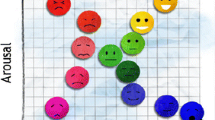Abstract
This paper proposes an emotion recognition system from EEG (Electroencephalogram) signals. The main objective of this work is to compare the efficacy of classifying human emotions using two discrete wavelet transform (DWT) based feature extraction with three statistical features. An audio-visual induction based protocol has been designed to acquire the EEG signals using 63 biosensors. Totally, 6 healthy subjects with an age group of 21–27 years old have been used in this emotion recognition experiment. In this work, we have used three statistical features (energy, Recoursing Energy Efficiency (REE) and Root Mean Square (RMS)) from the EEG signals for classifying four emotions (happy, disgust, surprise and fear). An unsupervised clustering called Fuzzy C-Means (FCM) clustering is used for distinguishing emotions. Results confirm the possibility of using “db4” wavelet transform based feature extraction with proposed statistical feature for assessing the human emotions from EEG signal.
Access this chapter
Tax calculation will be finalised at checkout
Purchases are for personal use only
Preview
Unable to display preview. Download preview PDF.
Similar content being viewed by others
References
Kim K.H, Band S.W., and Kim S.B. (2004). Emotion Recognition System using short-term monitoring of physiological signals. Proceedings on Medical & Biological Engineering & Computing, Vol 42, pp, 419–427.
Arikin R.C, Fujita M, Takagi T, Hasegawa R.(2001). Ethological modeling and architecture for an entertainment robot. IEEE Proceedings on Robotics and Automation, pp, 453–458.
Egon L, Broek V D, Schutt M H et.al. (2006). Computing Emotion Awareness Through Facial Electromyography. HCI/ECCV 2006, pp, 53–63.
Mallat S. G. (1989) A theory for multiresolution signal decomposition: the wavelet representation. IEEE Transactions on Pattern Anal. & Mach. Intelligence, Vol. 11(7), pp, 674–693.
Olivier R, Vetterli M. (1991). Wavelets and Signal processing. IEEE Signal processing Magazine, pp, 14–38.
DA-Zeng, Ming-Hu Ha (2004). Applications of Wavelet Transform in Medical Image Processing. IEEE Proce on Machine Learning and Cybernatics, Vol 3, pp, 1816–1821.
Qin S, Ji Z. (2004) Multi-Resolution Time-Frequency Analysis for Detection of Rhythms of EEG Signals. IEEE Proceedings on Signal Processing, Vol 4, pp, 338–341.
Glassman E L. (2005). A Wavelet-Like Filter Based on Neuron Action Potentials for Analysis of Human Scalp Electroencephalographs. IEEE Transactions on Biomedical Engineering, Vol 52(11), pp, 1851–1862.
Chethan P, Cox M. (2002), Frequency Characteristics of Wavelets, IEEE Transactions on Power Delivery, Vol 17(3), pp, 800–804.
WRC at http://www.wordsworthcentre.co.uk
Manikandan M S, Dandapat S. (2006). Wavelet threshold based ECG compression using USZZQ and Huffman coding of DSM. Journal of Biomedical Signal Processing and control, pp, 261–270.
Srinivasa K G, Venugopal K R, Patnaik L M. (2006), Feature Extraction using Fuzzy C-Means Clustering for Data Mining Systems, International Journal of Computer Science and Network Security, Vol 6(3A), pp, 230–236.
Channel G, Kronegg J, Grandjean D, Pun T (2006). Emotion assessment: Arousal evaluation using EEG’s and peripheral physiological signals. Lecture Notes on Computer Science, Vol 4105, Springer, pp, 530–537.
Author information
Authors and Affiliations
Corresponding author
Editor information
Editors and Affiliations
Rights and permissions
Copyright information
© 2008 Springer-Verlag Berlin Heidelberg
About this paper
Cite this paper
Murugappan, M., Rizon, M., Nagarajan, R., Yaacob, S., Hazry, D., Zunaidi, I. (2008). Time-Frequency Analysis of EEG Signals for Human Emotion Detection. In: Abu Osman, N.A., Ibrahim, F., Wan Abas, W.A.B., Abdul Rahman, H.S., Ting, HN. (eds) 4th Kuala Lumpur International Conference on Biomedical Engineering 2008. IFMBE Proceedings, vol 21. Springer, Berlin, Heidelberg. https://doi.org/10.1007/978-3-540-69139-6_68
Download citation
DOI: https://doi.org/10.1007/978-3-540-69139-6_68
Publisher Name: Springer, Berlin, Heidelberg
Print ISBN: 978-3-540-69138-9
Online ISBN: 978-3-540-69139-6
eBook Packages: EngineeringEngineering (R0)




